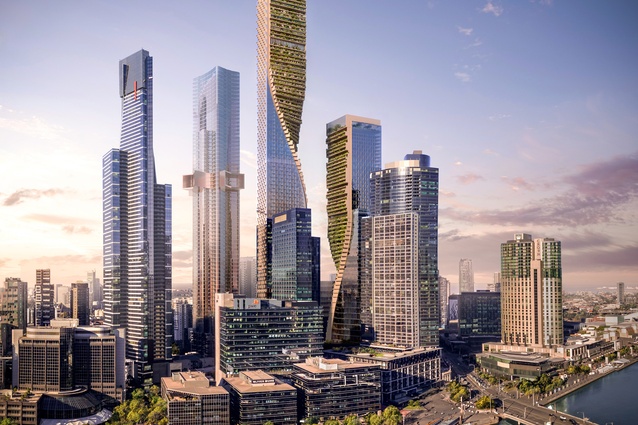(单词翻译:单击)
Modern cities heading back to nature
“绿色脊柱”将撑起墨市天空
When we think of how cities will look in the future, we probably picture tall gray buildings and skies filled with flying cars.
当我们想象未来城市的模样时,浮现在脑海中的或许会是高耸入云的灰色大楼以及满是飞行汽车的天空。
One city in Australia, however, is trying to change that image.
而澳大利亚的一座城市正试图改变这样的景象。
Earlier in last September , it was reported that the city of Melbourne plans to build a pair of tall towers, which look more like massive tree houses than skyscrapers.
据报道,去年九月初,墨尔本市计划建起两座高塔,它们看起来更像是巨大的书屋,而非摩天大楼。
The project, known as the Green Spine, will turn Melbourne's skyline from gray to green once the two towers are completed, with one of the buildings becoming the tallest in the Southern Hemisphere, at 356.2 meters tall.
该项目被称为“绿色脊柱”,两座高塔建成后将会为灰色的墨尔本天际线增添一抹绿色。而其中的一座高塔将成为南半球的最高建筑,高356.2米。

Both towers will have balconies running down one side, filled with plants and trees.
两座高塔的一侧都有露台贯穿全楼,种满植物与树木。
Meanwhile, on the top of each tower, a botanical garden will offer a relaxing space where visitors can enjoy nature, away from the noise of the city.
与此同时,每座高塔的顶层都有一个植物馆,为游客提供一个放松的环境,让他们能够享受自然,远离城市的喧嚣。
"Our green spaces are our city's lungs, its shade from the sun," building architect Phil Rowe said in a news release.
“我们的绿色空间是城市之肺,也是遮阳之处,”建筑师菲尔·罗维在一篇新闻稿中如此表示。
In spite of their proposed size, these buildings are just a small part of a wider trend for greener and more eco-friendly structures.
尽管这两座建筑规划的规模不小,但在追求更为环保的建筑大潮流中,它们不过是很小的一环而已。
Plans are already underway in several cities around the world to build entire skyscrapers from wood, with an 18-story building made from pine already existing in Minneapolis, US.
世界各地的多个城市都已经提出了用木头来建造整栋摩天大楼的计划,其中,美国的明尼阿波利斯市已经用松木建起了一座18层高的大楼。
Indeed, in this modern age of technology and tall buildings, it seems that people just want a touch of nature in their lives.
在这个科技与摩天大楼的时代,人们似乎的确想在自己的生活中加入点自然的元素。
"The 20th century was the concrete age; it was all about the dominion of man over nature," British architect Anthony Thistleton told the BBC.
“20世纪是混凝土时代,体现了人类对自然的征服,”英国建筑师安东尼·西斯尔顿在接受BBC采访时表示。
"Now, we're transitioning toward a different attitude, a more nurturing one."
“如今,我们的态度正变得截然不同,提倡反哺自然。”
The move toward making cities greener places isn't a new concept.
令城市变得更环保的举措并不是一个新概念。
One just needs to look at places such as New York's Central Park to see that natural spaces and sprawling cities have been partners for hundreds of years.
看看纽约的中央公园等地是如何令自然环境与扩张的城市和谐共处数百年就明白了。
And, of course, wooden buildings themselves have been around far longer than concrete and steel ones.
当然,木质建筑出现的时间也比混凝土与钢筋建筑要早得多。
In fact, China's wooden Fogong Temple Pagoda, located in Shanxi province, is still standing almost 1,000 years after it was built.
事实上,近千年前建成的中国山西省的佛宫塔如今仍然屹立不倒。
So, like many other trends from fashion to technology, it seems that humankind is taking a step backwards to a simpler time.
所以,就像从时尚到科技等其他领域的诸多趋势一样,人类似乎正在回到一个更简单的时代。
Our future may not be as we pictured it, but it'll certainly be a lot greener.
我们的未来或许与我们所畅想的并不一样,但一定会变得更加环保。


